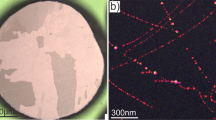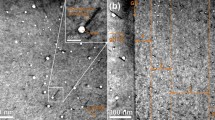Abstract
VOIDS in metals, formed as a result of neutron irradiation or particle bombardments, are usually found to be distributed randomly in the lattice. But I have found that voids can take up regular positions in the lattice with respect to each other and demonstrate that the voids form a body-centred-cubic superlattice structure with crystallographic axes identical with those of the molybdenum matrix. The voids in this case were formed as a result of particle irradiations but some observations made on neutron irradiated molybdenum (F. W. Wiffen, private communication) indicate strongly that this same void structure may be present in that case as well.
This is a preview of subscription content, access via your institution
Access options
Subscribe to this journal
Receive 51 print issues and online access
$199.00 per year
only $3.90 per issue
Buy this article
- Purchase on Springer Link
- Instant access to full article PDF
Prices may be subject to local taxes which are calculated during checkout
Similar content being viewed by others
Author information
Authors and Affiliations
Rights and permissions
About this article
Cite this article
EVANS, J. Observations of a Regular Void Array in High Purity Molybdenum irradiated with 2 MeV Nitrogen Ions. Nature 229, 403–404 (1971). https://doi.org/10.1038/229403a0
Received:
Issue Date:
DOI: https://doi.org/10.1038/229403a0
This article is cited by
-
Ordering the void
Nature Materials (2020)
-
Bifurcation and Pattern Symmetry Selection in Reaction-Diffusion Systems with Kinetic Anisotropy
Scientific Reports (2019)
-
Theoretical prediction and atomic kinetic Monte Carlo simulations of void superlattice self-organization under irradiation
Scientific Reports (2018)
-
Engineering self-organising helium bubble lattices in tungsten
Scientific Reports (2017)
-
Advancing towards constitutive equations for the metal industry via the LEDS theory
Metallurgical and Materials Transactions A (2004)
Comments
By submitting a comment you agree to abide by our Terms and Community Guidelines. If you find something abusive or that does not comply with our terms or guidelines please flag it as inappropriate.



